Legolas
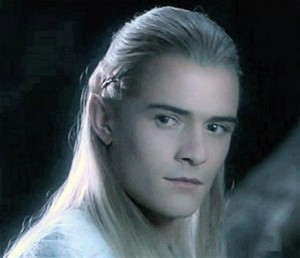 Description:
Description:
“Legolas is the Prince of the Woodland Realm and a high elf like his father Thranduil. However, you meet him rarely at the royal court — much rather he patrols the area with the forest guards of the Wood-elves. The large and slim versed fighter is absolutely loyal to his father and his people. But the events of the outside world by now leave traces in the isolated world of the Wood-elves. Because he sees the disaster coming, Legolas faces the choice to follow either his father or his conscience.”
Analysis and speculation:
The suggestion that Legolas breaks from his father could indicate one of two things: either he helps the dwarves in their escape from the Wood-elves kingdom, or it is he not Thranduil who leads the Wood-elves to the Lonely Mountain. The quote suggests the latter, as it notes ‘but the events in the outside world by now leave traces in the isolated world of the Wood-elves’. Releasing the dwarves has little relevance to ‘events in the outside world’. But leading an army to the Lonely Mountain would of course be in response to such events.
The Great Goblin (or “Goblin-King”)
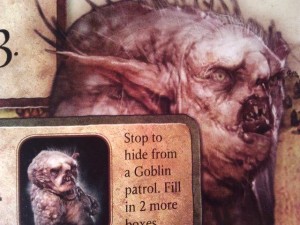 Description:
Description:
“The Great Goblin is a huge, grotesquely bloated monster that in the years of his tyrannical rule over the miserable inhabitants of the Goblin town grew fat and flabby. The Goblin town is a collection of skew-whiff ramshackle huts deep in the caves of the Misty Mountains. He commands a bunch of foul, polluted, with scars and ulcers studded goblins. Basically, they are bandits, they live by what they can pick up from passengers on the passes through the mountains. The Goblin King and his followers manage to capture Bilbo and the dwarves. The Goblin King is more wily and smarter than it seems. He takes pleasure in torturing his prisoners — he almost succeeds to finish off Thorin Oakenshield and his companions.”
Analysis and speculation:
The Great Goblin appears to be being presented as a petty warlord, one who nevertheless is quite minor in the big scheme of things. His death at the hands of the Company will trigger the rising up of the Goblins, which culminates in the Battle of the Five Armies. More on this below.
Grinnah
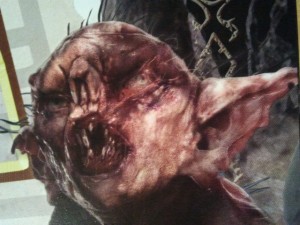 Description:
Description:
“Grinnah is the interrogation specialist of the goblins. He ensures that Thorin & Co. are brought before the Goblin King. He constantly carries a barbed whip and takes every opportunity to use it. Although cunning and vicious, he is like all goblins basically a coward. Fawning and obsequious, he serves his master, the rich and moody Goblin King, but secretly he despises him.”
Analysis and speculation:
This character may be invented, but it is necessary. Much as the Uruk-hai in FotR and the army at Pelennor Field needed a leader to give them dramatic and emotional heft, for the Goblin hordes to be engaging there will need to be some rendered as minor antagonists. Grinnah fulfills this role in Goblin Town.
I would further speculate that Grinnah also proves to be the goblin that not only shoots Balin in Moria (a cowardly act), but is the very same orc that is ‘grinning’ (hence the name ‘Grinnah’) at the fellowship just before the appearance of the Balrog in FotR. As a coward, he would have found a way to survive the Battle of the Five Armies.
Azog
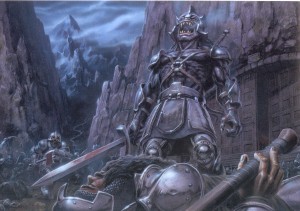 Description:
Description:
“It was said that Azog the Desecrator fell many years ago in the great battle between the Orcs and the Dwarves. But now he appears again at the top of a deadly horde of killer orcs. For Gandalf begins a race against time because he has to figure out the connection between the most dangerous orc commander and the growing evil, which takes shape in the ruins of the fortress of Dol Guldur. One thing is totally clear: no one will deter Azog from his intention to destroy Thorin Oakenshield’s companions to the last dwarf.”
Analysis and speculation:
In the appendices, Azog is presented as the chief antagonist in the historical Goblin Wars, set a century or more before the events of the Hobbit. In brief, Thror, an ancestor of Thorin, visited Moria from the Lonely Mountain in an attempt to recolonise it (Thror was King Under the Lonely Mountain when Smaug descended on the Kingdom). In Moria, Thror was killed by Azog, who was the Orc Chieftain in Moria, and therefore of all Orcs. Thror’s body was mutilated, with ‘AZOG’ carved into the brow of his severed head, and a purse of money stuffed in his mouth. This desecration sparked the Dwarf-Goblin wars, which culminated in the Battle of Azanulbizar at the gates of Moria (the gates out of which the Fellowship ran following the encounter with the Balrog). Azog is then killed at Azanulbizar by Dain Ironfoot (who will appear at the Lonely Mountain at the Battle of the Five Armies in There and Back Again, and is played by Billy Connolly. Although this may have been a joke, Connolly has claimed that the character will be rocking a mohawk). Dain decapitates Azog, and puts the purse of money in his mouth.
Now in this film trilogy version, it is clear that Azog is not killed at Azanulbizar, and indeed, the filmmakers are making Azog the chief Orc antagonist of the trilogy. As the chief antagonist (apart from Smaug, who I’ve argued elsewhere is like Saruman in Lord of the Rings: the primary antagonist of films one and two, but the secondary antagonist of the trilogy), he will therefore likely be the leader of the Goblin forces at the Battle of the Five Armies, the centrepiece of the third film, There and Back Again. This makes sense, as Sauron cannot be there in person (as he has no body), and Azog will therefore embody the rising evil in Middle-earth for the purposes of the film.
For symmetry, it is however likely that Azog will still be killed by Dain Ironfoot, who might still stuff the purse of coins in his mouth. Thus Thorin, Fili and Kili might still all fall to his bodyguard as in the book, but instead of Beorn killing Bolg (the son of Azog, who in the Hobbit book is the leader of the Goblin forces at the Battle of the Five Armies), it is Dain killing Azog. This would make sense dramatically, as it would help legitimise Dain as the new King under the Mountain, which he becomes in the book following Thorin’s death.
The key question is where will Azog make his actual entry in the films? Bear in mind that the character of Azog might well have been introduced via a flashback to Azanulbizar in Rivendell, a tale that will likely be told by Thorin, who was of course present at that battle. Yet it appears that instead of showing Azog’s death, they will only indicate that he is thought to have died. Thus there will need to be a dramatic ‘reveal’ that he survived the battle.
We can perhaps infer when this might happen from the figurine descriptions. The official description for Fimbul (below) states ‘Fimbul is one of Azog’s master hunters’, which suggests that Azog’s forces ride upon wargs. Bolg’s description (also below) notes how ‘like his father, he is a huge pale orc’, indicating Azog is himself a pale orc, much like the orc commander at the Battle of Pelennor in RotK. Remember that that orc rode upon a warg himself. All this indicates that Azog himself will ride upon a warg.
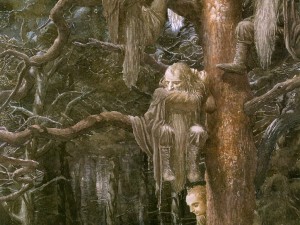
Thus what will be most likely is that, following their escape from the Misty Mountains, Thorin and Co. will be forced up trees and surrounded by a forward team of wargs and orcs as in the book (in the films, this pack will likely be led by Yazneg, to be played by John Rawls. Yazneg, a new character, apparently appears in two films, which suggests that he might then re-appear as a second-in-command to Azog at the Battle of the Five Armies). From the top of his tree, Thorin will be able to see orc reinforcements coming from all directions. Clearly all hope is lost.
But Thorin suddenly sees one great orc among them, entering the clearing below the trees. To his horror, it is clearly Azog, thought to be long dead (it is possible that Bifur will also recognise Azog, if he is written to have had the axe embedded in his head by Azog himself at Azanulbizar). Azog himself recognises Thorin. It is at this point that the eagles swoop down and rescue the company.
This fleeting introduction would allow for several things.
First, the shocking revelation that Azog is alive and well and in command of a large force. This will appear as no coincidence to Gandalf, given the revelation that the Witch-king has been released from his tomb, suggests that both have possibly been ‘necromanced’ back from the dead, or at any rate mobilised by some greater power. One can just imagine the dialogue between Thorin and Gandalf following this close encounter with Azog:
Thorin: ‘But I saw him die over a century ago! How is he alive?’
Gandalf: ‘Much that was once certain is no longer. The world is growing stranger with the seasons. This is not the most concerning omen of our journey, only the most recent. The dead walk abroad, and I must go to Dol Guldur. There is a power at work, a dark power. Necromancy serves a purpose, and one greater than purely to inconvenience you, Thorin.’
Thus this scene will allow Gandalf to discover the connection between Azog and Dol Guldur.
Third, the scene would rekindle the antagonism between Thorin and Azog, which provides the backdrop for Fimbul’s harrying of the Company all the way to the Lonely Mountain (see Fimbul’s description below), and Azog’s eventual marshalling of the orcs for the Battle of the Five Armies.


